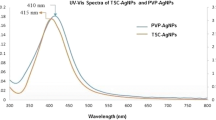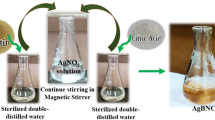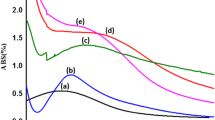Abstract
Heliotropium crispum-mediated assembly of silver nanoparticles exhibit profound antibacterial and anti-biofilm effects against multiple drug-resistant bacteria, but its stability and biocompatibility remain a hurdle in commercialization. Herein, we adopted a surface chemistry-based steric repulsion approach to investigate the colloidal stability of H. crispum silver nanoparticles (HC-AgNPs) and determine its application as a commercial antibacterial formulation. Two primary silver nanoparticles (AgNPs) were synthesized, i.e., HC-AgNPs and citrate-HC-AgNPs initially, which were then modulated to assemble various derivatives of AgNPs using polyethylene glycol (PEG) and polyvinylpyrrolidone (PVP) as stabilizing agents. Various parameters were assessed to investigate the morphology, colloidal physio-chemistry, and surface capping using various analytical techniques, such as UV–Vis spectrophotometer, zeta–dynamic light scattering (DLS), Fourier transform infrared spectroscopy (FTIR), scanning electron microscopy (SEM, and transmission electron microscopy (TEM). Selective AgNPs were then screened on the basis of stability for up to 8 months, heat resistance at 100 °C, and bioactivity via MTT assay using HEP-2, MCF-7, and HCEC cell lines. The UV–Vis and electron microscope results revealed that HC-AgNPs confer near-spherical and slight triangular-shaped morphology and the size of all synthesized AgNPs is in the range of 400–450 nm. All AgNPs synthesized from HC-source have characteristic FTIR peaks recorded near 2931 cm−1, 1996 cm−1, and 825 cm−1. This study highlights promising evidence for the commercial application of HC-AgNPs as an antimicrobial agent. Additionally, it provides a methodology for modulating the surface capping of biological nanoparticles and assesses its corresponding effect on the stability.









Similar content being viewed by others
Data availability
The data that support our studies are available from the corresponding authors on request.
References
Afshinnia K, Sikder M, Cai Bo, Baalousha M (2017) Effect of nanomaterial and media physicochemical properties on Ag NM aggregation kinetics. J Colloid Interface Sci 487:192–200
Ashraf S, Abbasi AZ, Pfeiffer C, Hussain SZ, Khalid ZM, Gil PR, Parak WJ, Hussain I (2013) Protein-mediated synthesis, pH-induced reversible agglomeration, toxicity and cellular interaction of silver nanoparticles. Colloids Surf B 102:511–518
Banerjee S, Loza K, Meyer-Zaika W, Prymak O, Epple M (2014) Structural evolution of silver nanoparticles during wet-chemical synthesis. Chem Mater 26:951–957
Brown AN, Smith K, Samuels TA, Jiangrui Lu, Obare SO, Scott ME (2012) Nanoparticles functionalized with ampicillin destroy multiple-antibiotic-resistant isolates of Pseudomonas aeruginosa and Enterobacter aerogenes and methicillin-resistant Staphylococcus aureus. Appl Environ Microbiol 78:2768–2774
Brown PK, Qureshi AT, Moll AN, Hayes DJ, Todd W et al (2013) Silver nanoscale antisense drug delivery system for photoactivated gene silencing. ACS Nano 7:2948–2959
Dallas P, Sharma VK, Zboril R (2011) Silver polymeric nanocomposites as advanced antimicrobial agents: classification, synthetic paths, applications, and perspectives. Adv Coll Interface Sci 166:119–135
de Barros C, Nasi H, Cruz GCF, Mayrink W, Tasic L (2018) Bio-based synthesis of silver nanoparticles from orange waste: effects of distinct biomolecule coatings on size, morphology, and antimicrobial activity. Nanotechnol Sci Appl 11:1
Eising R, Signori AM, Fort S, Domingos JB (2011) Development of catalytically active silver colloid nanoparticles stabilized by dextran. Langmuir 27:11860–11866
El-Rafie MH, El-Naggar ME, Ramadan MA, Fouda MMG, Al-Deyab SS, Hebeish A (2011) Environmental synthesis of silver nanoparticles using hydroxypropyl starch and their characterization. Carbohydr Polym 86:630–635
El-Shishtawy RM, Asiri AM, Al-Otaibi MM (2011) Synthesis and spectroscopic studies of stable aqueous dispersion of silver nanoparticles. Spectrochim Acta Part A Mol Biomol Spectrosc 79:1505–1510
Badawy El, Amro M, Silva RG, Morris B, Scheckel KG, Suidan MT, Tolaymat TM (2010) Surface charge-dependent toxicity of silver nanoparticles. Environ Sci Technol 45:283–287
Fayaz AM, Balaji K, Kalaichelvan PT, Venkatesan R (2009) Fungal based synthesis of silver nanoparticles—an effect of temperature on the size of particles. Colloids Surf B 74:123–126
Gericke M, Pinches A (2006) Biological synthesis of metal nanoparticles. Hydrometallurgy 83:132–140
Gutierrez L, Aubry C, Cornejo M, Croue J-P (2015) Citrate-coated silver nanoparticles interactions with effluent organic matter: influence of capping agent and solution conditions. Langmuir 31:8865–8872
Haberl N, Hirn S, Wenk A, Diendorf J, Epple M, Johnston BD, Krombach F, Kreyling WG, Schleh C (2013) Cytotoxic and proinflammatory effects of PVP-coated silver nanoparticles after intratracheal instillation in rats. Beilstein J Nanotechnol 4:933–940
Hoppe CE, Lazzari M, Pardiñas-Blanco I, Arturo López-Quintela M (2006) One-step synthesis of gold and silver hydrosols using poly(N-vinyl-2-pyrrolidone) as a reducing agent. Langmuir 22:7027–7034
Hotze EM, Phenrat T, Lowry GV (2010) Nanoparticle aggregation: challenges to understanding transport and reactivity in the environment. J Environ Qual 39:1909–1924
Huynh KA, Chen KL (2011) Aggregation kinetics of citrate and polyvinylpyrrolidone coated silver nanoparticles in monovalent and divalent electrolyte solutions. Environ Sci Technol 45:5564–5571
Kelly KL, Coronado E, Zhao LL, Schatz GC (2003) The optical properties of metal nanoparticles: the influence of size, shape, and dielectric environment. ACS Publications, New York
Khan F, Hashmi MU, Khalid N, Hayat MQ, Ikram A, Janjua HA (2016) Controlled assembly of silver nano-fluid in Heliotropium crispum extract: A potent anti-biofilm and bactericidal formulation. Appl Surf Sci 387:317–331
Kvitek L, Panáček A, Soukupova J, Kolář M, Večeřová R, Prucek R, Holecova M, Zbořil R (2008) Effect of surfactants and polymers on stability and antibacterial activity of silver nanoparticles (NPs). J Phys Chem C 112:5825–5834
Levard C, Matt Hotze E, Lowry GV, Brown GE, Jr. (2012) Environmental transformations of silver nanoparticles: impact on stability and toxicity. Environ Sci Technol 46:6900–6914
Morgan E, Wupperfeld D, Morales D, Reich N (2019) Shape matters: Gold nanoparticle shape impacts the biological activity of siRNA delivery. Bioconjug Chem 30:853–860
Mulfinger L, Solomon SD, Bahadory M, Jeyarajasingam AV, Rutkowsky SA, Boritz C (2007) Synthesis and study of silver nanoparticles. J Chem Educ 84:322
Piao MJ, Kang KA, Lee IK, Kim HS, Kim S, Choi JY, Choi J, Hyun JW (2011) Silver nanoparticles induce oxidative cell damage in human liver cells through inhibition of reduced glutathione and induction of mitochondria-involved apoptosis. Toxicol Lett 201:92–100
Pinto VV, Ferreira MJ, Silva R, Santos HA, Silva F, Pereira CM (2010) Long time effect on the stability of silver nanoparticles in aqueous medium: effect of the synthesis and storage conditions. Colloids Surf A 364:19–25
Qiu L, McCaffrey R, Zhang W (2018) Synthesis of metallic nanoparticles using closed-shell structures as templates. Chem Asian J 13:362–372
Rajput S, Werezuk R, Lange RM, McDermott MT (2016) Fungal isolate optimized for biogenesis of silver nanoparticles with enhanced colloidal stability. Langmuir 32:8688–8697
Ravindran A, Chandran P, Sudheer Khan S (2013) Biofunctionalized silver nanoparticles: advances and prospects. Colloids Surf B 105:342–352
Romer I, White TA, Baalousha M, Chipman K, Viant MR, Lead JR (2011) Aggregation and dispersion of silver nanoparticles in exposure media for aquatic toxicity tests. J Chromatogr A 1218:4226–4233
Römer I, White TA, Baalousha M, Chipman K, Viant MR, Lead JR (2011) Aggregation and dispersion of silver nanoparticles in exposure media for aquatic toxicity tests. J Chromatogr A 1218:4226–4233
Sastry M, Mayya KS, Bandyopadhyay K (1997) pH Dependent changes in the optical properties of carboxylic acid derivatized silver colloidal particles. Colloids Surf A 127:221–228
Sharma VK, Siskova KM, Zboril R, Gardea-Torresdey JL (2014) Organic-coated silver nanoparticles in biological and environmental conditions: fate, stability and toxicity. Adv Colloid Interface Sci 204:15–34
Srikar SK, Giri DD, Pal DB, Mishra PK, Upadhyay SN (2016) Green synthesis of silver nanoparticles: a review. Green Sustain Chem 6:34
Suman TY, Radhika Rajasree SR, Kanchana A, Beena S, Elizabeth. (2013) Biosynthesis, characterization and cytotoxic effect of plant mediated silver nanoparticles using Morinda citrifolia root extract. Colloids Surf B 106:74–78
Tenzer S, Docter D, Kuharev J, Musyanovych A, Fetz V, Hecht R, Schlenk F, Fischer D, Kiouptsi K, Reinhardt C (2013) Rapid formation of plasma protein corona critically affects nanoparticle pathophysiology. Nat Nanotechnol 8:772
Yin Y, Li Z-Y, Zhong Z, Gates B, Xia Y, Venkateswaran S (2002) Synthesis and characterization of stable aqueous dispersions of silver nanoparticles through the Tollens process. J Mater Chem 12:522–527
Zhang H, Smith JA, Oyanedel-Craver V (2012) The effect of natural water conditions on the anti-bacterial performance and stability of silver nanoparticles capped with different polymers. Water Res 46:691–699
Zonooz NF, Salouti M (2011) Extracellular biosynthesis of silver nanoparticles using cell filtrate of Streptomyces sp. ERI-3. Sci Iran 18:1631–1635
Acknowledgements
The authors would like to acknowledge Atta ur Rehman School of Biosciences, NUST for funding the current research, Department of Chemistry, SBASSE, LUMS for characterization of nanoparticles.
Funding
The authors are grateful to ASAB-NUST for MS student’s research funds to run this project.
Author information
Authors and Affiliations
Corresponding author
Ethics declarations
Conflict of interest
All the authors declared no conflict of interest in the current research.
Additional information
Publisher's Note
Springer Nature remains neutral with regard to jurisdictional claims in published maps and institutional affiliations.
Electronic supplementary material
Below is the link to the electronic supplementary material.
Rights and permissions
About this article
Cite this article
Khan, F., Iqbal, S., Khalid, N. et al. Screening and stability testing of commercially applicable Heliotropium crispum silver nanoparticle formulation with control over aging and biostability. Appl Nanosci 10, 1941–1956 (2020). https://doi.org/10.1007/s13204-020-01333-x
Received:
Accepted:
Published:
Issue Date:
DOI: https://doi.org/10.1007/s13204-020-01333-x




